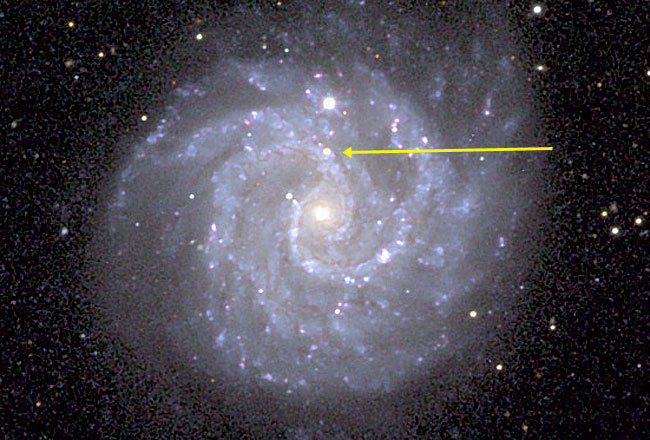Explanation: New evidence has emerged that a mysterious type of explosion known as a gamma ray burst is indeed connected to a supernova of the type visible in the above image. Two weeks ago, the orbiting HETE satellite detected gamma-ray burst GRB030329. The extremely bright burst was found hours later to have an extremely bright afterglow in visible light, and soon set the record for the closest measured distance at redshift 0.17. The afterglow brightness allows unprecedented coverage of its evolution. Just this week, as many astronomers suspected would happen, the afterglow began to appear as a fading Type II Supernova. Type II Supernovas might not appear coincident with gamma-ray bursts, however, when the gamma-ray beam goes in another direction. The above spiral galaxy, NGC 3184, was home to a Type II Supernova in 1999 at the position of the arrow. Astronomers are currently pressing hard to find the host galaxy for GRB030329.
1999 2000 2001 2002 2003 2004 2005 2006 2007 2008 2009 2010 2011 2012 2013 2014 2015 2016 2017 2018 2019 2020 2021 2022 2023 2024 2025 |
Yanvar' Fevral' Mart Aprel' Mai Iyun' Iyul' Avgust Sentyabr' Oktyabr' Noyabr' Dekabr' |
NASA Web Site Statements, Warnings, and Disclaimers
NASA Official: Jay Norris. Specific rights apply.
A service of: LHEA at NASA / GSFC
& Michigan Tech. U.
|
Publikacii s klyuchevymi slovami:
GRB 030329 - gamma-ray burst - supernova - gamma-vspleski - GRB - Sverhnovye
Publikacii so slovami: GRB 030329 - gamma-ray burst - supernova - gamma-vspleski - GRB - Sverhnovye | |
Sm. takzhe:
Vse publikacii na tu zhe temu >> | |
